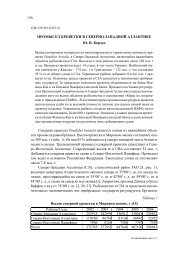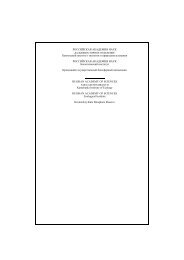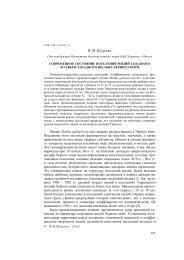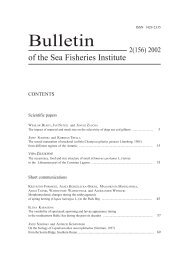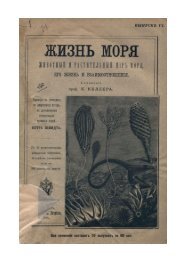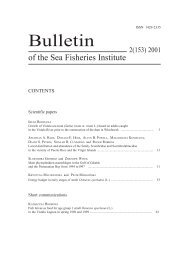Bulletin of the Sea Fisheries Institute 1 (155) 2002 - CEEMaR
Bulletin of the Sea Fisheries Institute 1 (155) 2002 - CEEMaR
Bulletin of the Sea Fisheries Institute 1 (155) 2002 - CEEMaR
You also want an ePaper? Increase the reach of your titles
YUMPU automatically turns print PDFs into web optimized ePapers that Google loves.
Fecundity <strong>of</strong> walleye pollock (Theragra chalcogramma Pallas) .. 29<br />
Maturity ogives were determined for males and females separately based on <strong>the</strong> percentage<br />
<strong>of</strong> fish which reached sexual maturity in each length class. The dependency between length<br />
and <strong>the</strong> frequency <strong>of</strong> mature fish was described by <strong>the</strong> following logistic curve equation (Rickey<br />
1995):<br />
1<br />
Y =<br />
−( a+<br />
bL)<br />
(1 + e )<br />
where: Y – percentage <strong>of</strong> mature fish;<br />
L – fish length (in cm);<br />
a and b – equation coefficients;<br />
from which, <strong>the</strong> fork length at which 50% <strong>of</strong> <strong>the</strong> fish reach sexual maturity was described with<br />
<strong>the</strong> equation (Seber 1982):<br />
L<br />
50% =<br />
−a<br />
b<br />
RESULTS<br />
In February and March 2000, walleye pollock formed dense pre-spawning concentrations <strong>of</strong>f<br />
<strong>of</strong> <strong>the</strong> southwest coast <strong>of</strong> Kamchatka at depths from 450 to 520 m (Fig. 1). Individuals from 21<br />
to 76 cm in length and from 2 to 23 years <strong>of</strong> age occurred in <strong>the</strong> samples. In February and<br />
March <strong>the</strong> female percentage <strong>of</strong> <strong>the</strong> catches was 61.4 and 63.9%, respectively. Approximately<br />
75% <strong>of</strong> both male and female fish caught were aged from 5 to 7. The length distribution and age<br />
structure <strong>of</strong> <strong>the</strong> fish caught is presented in Fig. 2.<br />
The systematic increase in <strong>the</strong> number <strong>of</strong> specimens with ei<strong>the</strong>r maturing or mature gonads<br />
was observed between February and March. This was especially apparent in walleye<br />
pollock males; in February 67.0% <strong>of</strong> <strong>the</strong>m had gonads in maturity stages IV and V, while<br />
64.4% had gonads in stages V and VI in March. No females in maturity stage VI (spawning)<br />
were observed in <strong>the</strong> catches; however, <strong>the</strong>re was a clear increase in <strong>the</strong> number <strong>of</strong> specimens<br />
with gonads in maturity stage IV from 44.5 to 71.5% (Fig. 3).<br />
A close correlation between length and <strong>the</strong> frequency <strong>of</strong> mature fish as described by <strong>the</strong><br />
logistic curve equation was found. The correlation coefficient (R 2 ) <strong>of</strong> <strong>the</strong>se equations for males<br />
and females was 0.987 and 0.997, respectively. It was determined that 50% <strong>of</strong> <strong>the</strong> males were<br />
ready for spawning after <strong>the</strong>y attained a length <strong>of</strong> 33.5 cm, while 50% <strong>of</strong> <strong>the</strong> females did so at<br />
a length <strong>of</strong> 37.4 cm (Fig. 4). The smallest mature males were 30 cm long and <strong>the</strong> smallest<br />
females were 33 cm long.<br />
Absolute fecundity ranged from 67.7 to 724.5 thousand eggs and, in general, it increased<br />
with walleye pollock specimen length (Table1), weight (Table 2) and age (Table 3). The regression<br />
equations that were devised for <strong>the</strong> various dependencies, including <strong>the</strong> correlation coefficients,<br />
can be found in Table 4.<br />
The specimen weight-fecundity and age-fecundity dependencies were linear, while <strong>the</strong><br />
length-fecundity dependence was expressed by a power function. The values <strong>of</strong> <strong>the</strong> coefficients<br />
<strong>of</strong> walleye pollock fecundity that were obtained indicated that it was most dependent on specimen<br />
weight, followed by fork length. The dependence between age and fecundity had a ra<strong>the</strong>r<br />
high correlation coefficient at R 2 = 0.51 (Table 5). However, <strong>the</strong> value <strong>of</strong> this result is lowered



